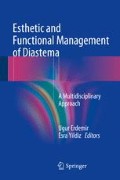Abstract
Recent development and improvements in dental technology have made it possible to restore teeth as same as natural, biomimetic, and functional by creating a strong bond between tooth structures with minimal invasive or no tooth preparation by preserving the healthy tooth. Innovations in the resin composites’ material formulation have led to the use of new monomers and fine inorganic fillers in the material composition, and these improvements have allowed reduced polymerization shrinkage, high mechanical and physical properties, and high polishability and also mimic nearly as the same natural tooth structures. Moreover, advances in ceramic technology have also led to major development in these systems typically reinforced materials that withstand occlusal forces and translucency that mimic natural tooth structures in the esthetic zone.
Access this chapter
Tax calculation will be finalised at checkout
Purchases are for personal use only
References
Oquendo A, Brea L, David S. Diastema: correction of excessive spaces in the esthetic zone. Dent Clin N Am. 2011;55(2):265–8.
Hwang SK, Ha JH, Jin MU, Kim SK, Kim YK. Diastema closure using direct bonding restorations combined with orthodontic treatment: a case report. Restor Dent Endod. 2012;37(3):165–9.
Willhite C. Diastema closure with freehand composite: controlling emergence contour. Quintessence Int. 2005;36(2):138–40.
Gurel G. The science and art of porcelain laminate veneers. Carol Steam: Quintessence Publishing Co. Ltd., Ergolding, Germany; 2003. p. 369–90.
Ittipuriphat I, Leevailoj C. Anterior space management: interdisciplinary concepts. J Esthet Restor Dent. 2013;25(1):16–30.
Nazarian A. Closing the gap with minimal preparation veneers. Dent Today. 2006;25(12):70–1.
Devoto W, Saracinelli M, Manauta J. Composite in everyday practice: how to choose the right material and simplify application techniques in the anterior teeth. Eur J Esthet Dent. 2010;5(1):102–24.
Chen MH. Update on dental nanocomposites. J Dent Res. 2010;89(6):549–60.
Ferracane JL. Resin composite – state of the art. Dent Mater. 2011;27(1):29–38.
Ergücü Z, Türkün LS. Surface roughness of novel resin composites polished with one-step systems. Oper Dent. 2007;32(2):185–92.
Magne P, Holz J. Stratification of composite restorations: systematic and durable replication of natural aesthetics. Pract Periodontics Aesthet Dent. 1996;8(1):61–8.
Fahl Jr N. A polychromatic composite layering approach for solving a complex Class IV/direct veneer/diastema combination: Part II. Pract Proced Aesthet Dent. 2007;19(1):17–22.
Fahl Jr N. A solution for everyday direct restorative challenges. J Cosmetic Dent. 2010;26(3):56–68.
Terry DA. Direct applications of a nanocomposite resin system: part 1 – the evolution of contemporary composite materials. Pract Proced Aesthet Dent. 2004;16(6):417–22.
Burke FJ, Palin WM, James A, Mackenzie L, Sands P. The current status of materials for posterior composite restorations: the advent of low shrink. Dent Update. 2009;36(7):401–9.
Mitra SB, Wu D, Holmes BN. An application of nanotechnology in advanced dental materials. J Am Dent Assoc. 2003;134(10):1382–90.
Mackenzie L, Parmar D, Shortall AC, Burke FJ. Direct anterior composites: a practical guide. Dent Update. 2013;40(4):297–308.
Heintze SD, Rousson V, Hickel R. Clinical effectiveness of direct anterior restorations – a meta-analysis. Dent Mater. 2015;31(5):481–95.
Devoto W, Pansecchi D. Composite restorations in the anterior region: clinical and aesthetic performances. Pract Proced Aesthet Dent. 2007;19(8):465–70.
Ahmad I. Protocols for predictable aesthetic dental restorations. Oxford, UK: Blackwell Munksgaard, Blackwell Publishing Company; 2006. p. 55–76.
Gurel G. The science and art of porcelain laminate veneers. Carol Steam: Quintessence Publishing Co. Ltd., Ergolding, Germany; 2003. p. 19–58.
Schwartzman A, Zweig AE. Improved communication with the laboratory for the fabrication of labial veneers. J Calif Dent Assoc. 2015;43(4):203–8.
Bagis B, Turgut S. Optical properties of current ceramics systems for laminate veneers. J Dent. 2013;41 Suppl 3:e24–30.
Radz GM. Minimum thickness anterior porcelain restorations. Dent Clin N Am. 2011;55(2):353–70.
Dong JK, Luthy H, Wohlwend A, Schärer P. Heat-pressed ceramics: technology and strength. Int J Prosthodont. 1992;5(1):9–16.
Fasbinder DJ. Chairside CAD/CAM: an overview of restorative material options. Compend Contin Educ Dent. 2012;33(1):50–8.
Fasbinder DJ. Materials for chairside CAD/CAM restorations. Compend Contin Educ Dent. 2010;31(9):702–9.
Erdemir U, Sancakli HS, Sancakli E, Eren MM, Ozel S, Yucel T, Yildiz E. Shear bond strength of a new self-adhering flowable composite resin for lithium disilicate-reinforced CAD/CAM ceramic material. J Adv Prosthodont. 2014;6(6):434–43.
Gurel G. The science and art of porcelain laminate veneers. Carol Steam: Quintessence Publishing Co Ltd., Ergolding, Germany; 2003. p. 231–332.
Author information
Authors and Affiliations
Corresponding author
Editor information
Editors and Affiliations
Rights and permissions
Copyright information
© 2016 Springer International Publishing Switzerland
About this chapter
Cite this chapter
Yucel, T., Yildiz, E., Erdemir, U. (2016). Material Selection: Restorative Materials. In: Erdemir, U., Yildiz, E. (eds) Esthetic and Functional Management of Diastema. Springer, Cham. https://doi.org/10.1007/978-3-319-24361-0_13
Download citation
DOI: https://doi.org/10.1007/978-3-319-24361-0_13
Published:
Publisher Name: Springer, Cham
Print ISBN: 978-3-319-24359-7
Online ISBN: 978-3-319-24361-0
eBook Packages: MedicineMedicine (R0)

